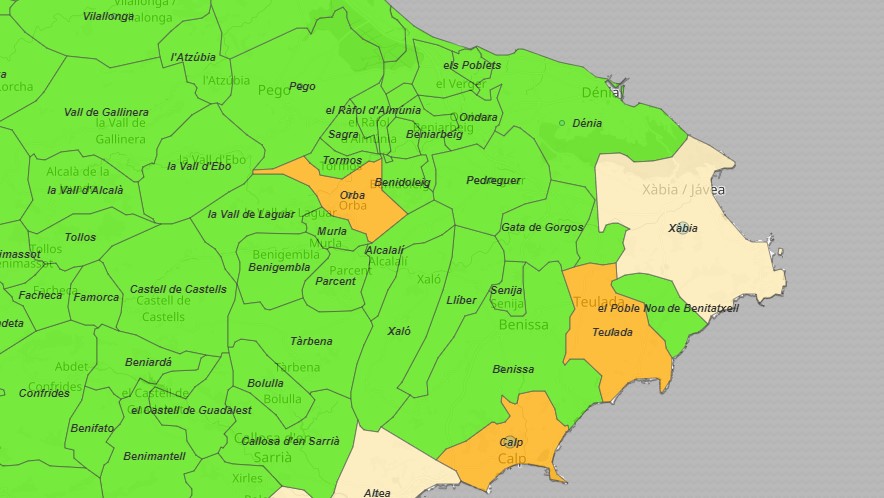VIRUS UPDATE: New outbreak detected in Xàbia, affecting three people
However, the municipality slips back into “Low Risk” level with a 14-day IA rate of 49.97, just below the “medium risk” threshold.

Friday 30th April 2021 – Compiled by MIKE SMITH
Another outbreak of coronavirus has been detected in Xàbia, the second this month, with three people affected; the origin has been determined as being “social”, and the vast majority of all outbreaks in the region in recent weeks have been from the same origin.
However, despite this, Xàbia has dropped back into the ‘Low Risk’ level after recording just two positive cases since Tuesday, resulting in the 14-day IA rate, a measure of the speed at which the virus moves through the population, dropping very slightly to 49.97 cases per 100,000 inhabitants. Since the pandemic began, 1,456 positive cases have been reported in Xàbia.
Orba (89.61), Teulada (88.67) and Calp (60.02) are the municipalities in the Marina Alta region that find themselves in the ‘Medium Risk’ category this Friday. Teulada’s infection spread rate has risen markedly after 10 positive tests for coronavirus were confirmed by PCR this week whilst Orba also recorded their first positive cases since March 24th.
Elsewhere Dénia recorded four new positive cases and Pego detected a single case. In total, the Marina Alta detected 22 new positive cases of coronavirus, although Teulada accounts for almost half of them.
The rest of the Marina Alta is coloured green, the ‘New Normal’ level, these municipalities having not recorded a new positive case since Tuesday, with region’s 14-day IA rate currently 31.65 cases per 100,000 inhabitants, well below the average for all health authorities in the Comunidad Valenciana.
Spain
Spain’s 14-day IA rate is 230.07 cases per 100,000 inhabitants, placing the country in the ‘High Risk’ category. The rate has been dropping slowly all week, along with the Positivity Rate, the measure of how many coronavirus tests return positive, which now stands at 7.33%; back in January 2021, it reached 17.6%.
Across the autonomous regions, the País Vasco still leads the way with a 14-day IA rate of 516.68, placing it firmly in the highest ‘Extreme Risk’ category along with seven others – Melilla, Madrid, Navarra, Cataluña, Aragón, La Rioja and Cantabria – whilst the Comunidad Valenciana (44.47) remains the only region in the ‘Low Risk’ level, although its rate has risen by 25% in the last two weeks. Infection spread has been dropping all week in six autonomous regions: Navarra, Andalucia, Ceuta, Asturias, Canarias and Extremadura; and it has been rising all week in two: La Rioja and Cantabria.
The newspaper El País has reported that several regions in Spain are looking to maintain restrictions after the national state of alarm comes to an end next weekend, some even calling on the Spanish Government to formally extend the state of alarm beyond May 9th. Although the so-called ‘fourth wave’ appears to be under control, regions want to be able to legally implement measures that they would not normally be able to do so without state sanction.
Of the three main measures – night curfew, perimetral lockdowns and social gatherings – the only one that is without legal backing once the state of alarm expires is the curfew. However, regions could use a 1986 public health law to enforce one since it allows them to adopt “measures that they consider necessary” in order to control the transmission of disease and then wait to see if it is challenged in the courts.
With particular concern over the Indian strain of the virus, experts fear that the suspension of measures currently enforced by the state of alarm could see a significant rise in infections, despite the Spanish Government’s hope that the ongoing vaccination campaign will serve to slow down any spread so that it remains under control. However, several regions including the Pais Vasco, Galicia, Castilla y León and Castilla-La Mancha are calling for an extension to the state of alarm, whilst Catalonia, Asturias and Andalucia are preparing working policies to cover planned restrictions. So it seems that the legal system should brace itself for a very busy period from May 10th.
Vaccination (29.04.21)
Spain has administered 15,859,772 doses of vaccine, which is 90.8% of those which it has already received. A total of 4,413,784 people have completed the recommended course, which is 11.0% of the total of the population which is to be vaccinated (40,129,822).
According to the latest data provided by the health authorities, 70.1% of people aged 60 and over in Spain have received at least one dose, with 25.6% having completed the recommended course.
The Comunidad Valenciana has administered 1,613,235 doses of vaccine, which is 94.7% of the total which it has received. A total of 438,808 people have completed the recommended course, which 10.2% of the population which is to be vaccinated (4,289,305).
According to the latest data provided by the health authorities, 66.8% of people aged 60 and over in the Comunidad Valenciana have received at least one dose, with 25.3% having completed the recommended course.
Links
Actualización nº 364. Enfermedad por el coronavirus (COVID-19). 29.04.2021
GIV COVID-19 Gestíon Integral de la Vacunación 29/04/2021
COVID-19 C. Valenciana: Monitoratge de la situació



